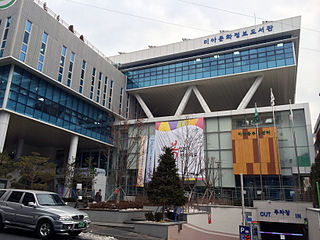
Mia-dong is a dong, neighbourhood of Gangbuk-gu in Seoul, South Korea. From June 30, 2008, nine administrative Mia-dongs were divided Mia-dong, Samgaksan-dong, Samyang-dong, Songcheon-dong and Songjung-dong. Remained Mia-dong is former Mia 3-dong.
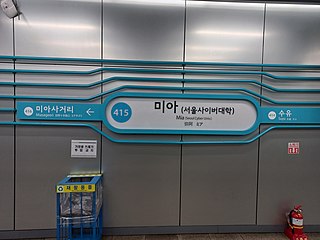
Mia Station is an underground station on the Seoul Subway Line 4. It is located in Mia-dong, Gangbuk-gu, Seoul, South Korea. Its station subname is Seoul Cyber Univ., where said university is nearby.

Suyu Station is an underground station on the Seoul Subway Line 4 in Suyu-dong, Gangbuk-gu, Seoul, South Korea.
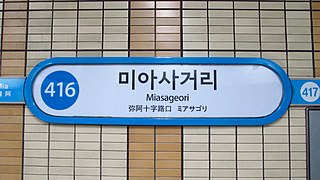
Miasageori Station is a station on the Seoul Subway Line 4. Its name means "four-way junction in Mia-dong." It is located in Mia-dong, Gangbuk-gu, Seoul. It was previously called Miasamgeori (미아삼거리), until December 26, 2013.

Bukhansan, or Bukhan Mountain, is a mountain on the northern periphery of Seoul, South Korea. There are three major peaks, Baegundae 836.5 meters (2,744 ft), Insubong 810.5 meters (2,659 ft), Mangyeongdae 787.0 meters (2,582.0 ft). Because of its height and the fact that it borders a considerable portion of the city, Bukhansan is a major landmark visible from most city districts. The name "Bukhansan" means "mountain north of Han River", referring to the fact that it is the northern border of the city. During the Joseon era, the peaks marked the extreme northern boundary of Seoul.
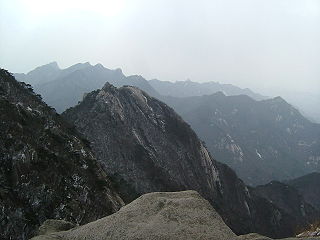
The Bukhansan National Park in Seoul and Gyeonggi covers an area of 79.92 km2 (30.86 sq mi) and was established on 2 April 1983. Bukhansan means "mountains north of the Han River."

Gangbuk District is one of the 25 gu which make up the city of Seoul, South Korea. Its name is derived from it being located at the north of Han river. It was created from neighbouring Dobong District in 1995. The current mayor is Park Gyeom-su.
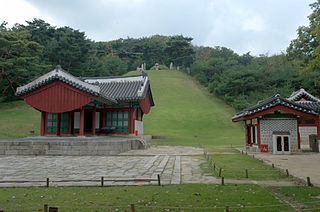
Seongbuk District is one of the 25 districts of Seoul, South Korea. The district is located in the mid-north part of the city. The current mayor is Kim Young-bae (김영배), who has been mayor since July 1, 2010. Seongbuk-gu was established under Presidential Decree No. 159 on August 13, 1949, and was promoted to a autonomous district by implementing a Gu-level local government on May 1, 1988.
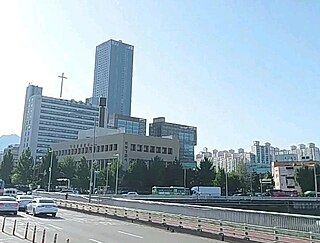
Dobong District is one of the 25 districts of Seoul, South Korea. As of 2020, Dobong has a population of 315,979 and an area of 20.71 square kilometres (8.00 sq mi), and is divided into four administrative neighborhoods. The district is located in northeastern Seoul, bordering the Gyeonggi Province cities of Yangju and Uijeongbu to the north, and the districts of Gangbuk to the southwest and Nowon to the east.

Bulgwang-dong is a neighborhood (dong) of Eunpyeong District, Seoul, South Korea.
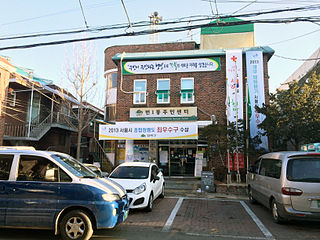
Beon-dong is a dong (neighborhood) of Gangbuk District, Seoul, South Korea.

Suyu-dong (Korean: 수유동) is a dong, neighbourhood of Gangbuk-gu in Seoul, South Korea. From June 30 of 2008, six administrative Suyu-dongs were divided to Insu-dong, Ui-dong, and Suyu-dong.
Ui-dong is a dong, neighbourhood of Gangbuk-gu in Seoul, South Korea. From June 30 of 2008, Former Suyu-4 dong is changed to the administrative dong. Thus Ui-dong can be called either legal dong or administrative dong.
Taepyeongno is a major thoroughfare in the central districts of Seoul, South Korea and the second longest road next to Sejongno in the Gangbuk area. With a 1.1 km length and a 50 m width, Taepyeongno originates at 139 Sejongno in Jongno-gu and terminates at Namdaemun in Jung-gu. It runs southwards through Sogong-dong, Jeong-dong, Taepyeongno 1, 2 ga-dong, Bukchang-dong and Mugyo-dong. Numerous landmarks along here include Koreana Hotel.
Sangam-dong is a legal dong (neighborhood) of the Mapo District in Seoul, South Korea. In the wake of the 2002 FIFA World Cup, a large apartment complex and DMC business district have been created and developed into the center of western Seoul.
Songjung-dong is a dong, neighbourhood of Gangbuk-gu in Seoul, South Korea. From June 30 of 2008, Former Mia-4 and 9 dongs are combined for this dong.
Songcheon-dong is a dong, neighbourhood of Gangbuk-gu in Seoul, South Korea. From June 30 of 2008, Former Mia-5 and 8 dongs are combined for this dong.
Samyang-dong is a dong, neighbourhood of Gangbuk-gu in Seoul, South Korea. From June 30 of 2008, Former Mia-1 and 2 dongs are combined for this dong.
Insu-dong (Korean: 인수동) is a dong, neighbourhood of Gangbuk-gu in Seoul, South Korea. From 30 June 2008, the former Suyu-5 and 6 dong were combined to form this dong.












